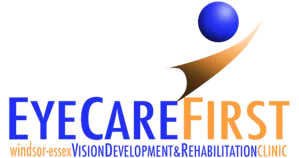Screen Time and How It Affects Our Eyes!

- posted: Apr. 03, 2020
By Dr. Britney Hewitt, OD
The past few weeks have been pretty crazy for the world. Like many of you, I am not working currently. As much as this stresses me, I am trying to stay positive each day by doing things that I love. I’m thankful that I can still run outside daily (of course while keeping social distance), and that I am able to spend more time with my fiancé and cat. My cat isn’t as happy about it as I am though.
Despite some of the positives, I do miss having a regular work schedule and routine. What I miss most is helping others and talking to my patients each day. So, I hope some of you find this information helpful during this time.
Now more than ever we are glued to digital screens all day- whether it is binge watching Netflix’s Tiger King on our tablets, scrolling through Instagram on our phones, or being productive on the computer. We are constantly staring at screens.
Anyone using the computer or digital screen for two or more hours throughout the day is likely to experience something known as Computer Vision Syndrome (CVS)1, 2. CVS encompasses symptoms such as eye strain, blurred vision, headaches, burning/watery and dry eyes1, 2.
There are many factors that can influence the severity of these symptoms. Evaporative dry eye is one of them because when we are focussed on screens we aren’t blinking nearly enough, causing our essential tear layers to evaporate3. Without proper hydration this can cause our eyes to burn, water, feel tired, or appear red3.
Additionally, vision issues such as hyperopia (farsightedness), astigmatism (oval shaped eye) or presbyopia (age-related weakening) can cause these symptoms1, 2. This means that some people require glasses with a specific prescription in order to relieve any strain on the visual system or simply just to see clearly. In some cases, people who wear glasses for distance may need a different prescription for near1, 2. Even if your vision is 20/20 you can still experience digital eye strain and may require glasses for specific tasks1, 2.
Binocular vision problems can also cause these symptoms as well1. This can occur when both eyes aren’t working together as a team or are unable to focus properly1. Glasses are often not a solution in these cases1.
What can we do to prevent these symptoms?
- Take breaks! Use the 20-20-20 rule4. For every 20 minutes you have been on the computer or cellphone you should look 20 feet away for 20 seconds. This helps to relax the focussing eye muscles4.
- Proper lighting to avoid glare while on the computer is also helpful1, 2. Continual exposure to glare can make your eyes work extra hard to see the details on your screen1. Anti-glare screens can work well for this or just simply closing the blinds to prevent glare off of the screen1, 2.
- Blinking our eyes often isn’t something we think about naturally but is important to prevent dry eye3. This can be supplemented by using artificial tears3.
- Ensure you have the optimal prescription glasses for the tasks that you do on a regular basis1, 2.
- Binocular vision problems often require vision therapy rather than glasses1, 2.
Getting your eyes checked by an optometrist will help identify whether you are prone to digital eye strain and why. Some of the symptoms described could be due to other conditions and should be investigated by an eye care professional. Each person is unique and requires unique care!
I am excited to be back in the office to help some of you get the proper glasses for reading or screen time. If there are any other eye topics that interest you, please let me know! I hope you are all staying healthy.
References
- KY Loh and SC Redd. 2008. Understanding and Preventing Computer Vision Syndrome. Malays Fam Physician.3 (3), 128-130.
- American Optometric Association. 2020. Computer Vision Syndrome. Retrieved from https://www.aoa.org/patients-and-public/caring-for-your-vision/protecting-your-vision/computer-vision-syndrome on 2020-03-29.
- Quan Findlay a nd Kate Reid. 2018. Dry eye disease: when to treat and when to refer. Australian Prescriber 41 (5), 160-163.
- Canadian Association of Optometrists. The 20-20-20 rule. Retrieved from https://opto.ca/health-library?tour=eye_health_library_tour&step=0 on 2020-03-29
- Photo by Hal Gatewood on Unsplash
By Dr. Britney Hewitt, OD
Location
Find us on the map
Main Office
2601 Lauzon Pkwy, Unit 510
Windsor, ON N8T 3M4, Canada
Hours of Operation
Our Regular Schedule
9:00 am - 5:30 pm
9:00 am - 5:30 pm
9:00 am - 5:30 pm
9:00 am - 5:30 pm
9:00 am - 2:00 pm
Closed
Closed

